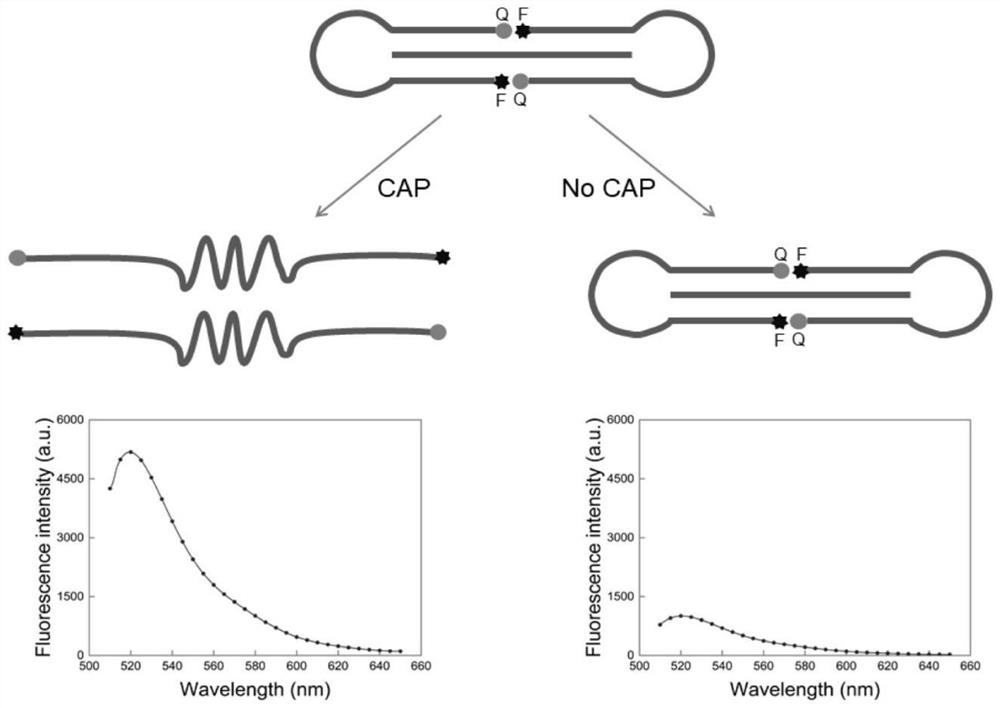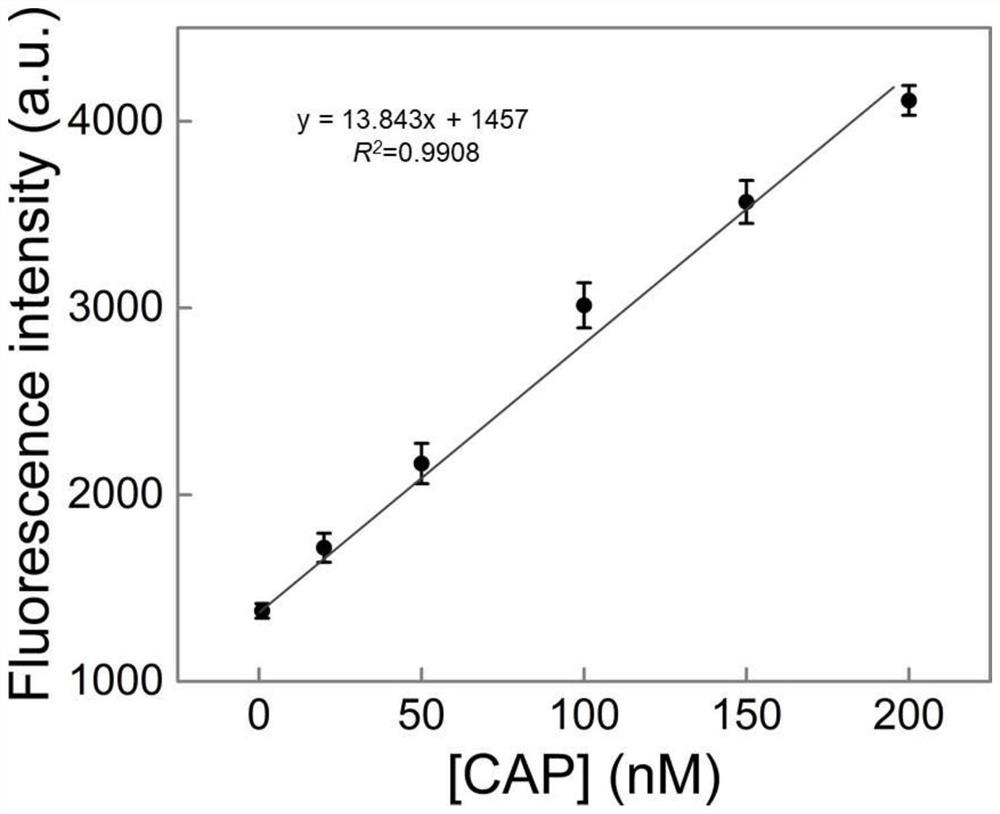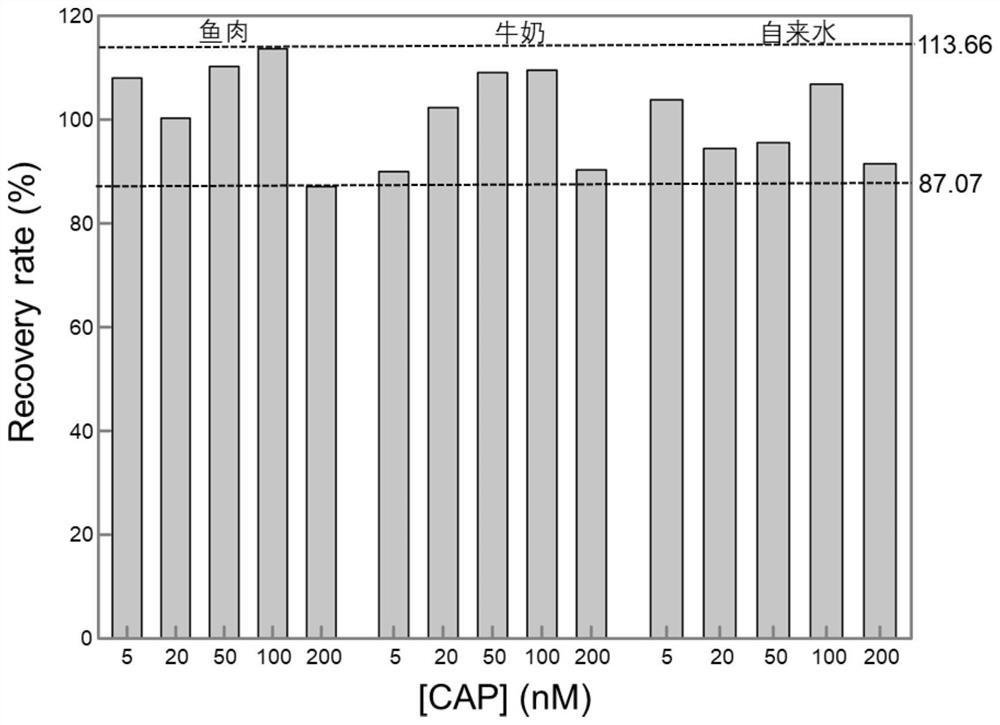Double-head triple-helix nucleic acid probe and method for detecting chloramphenicol
A nucleic acid probe and triple helix technology, applied in the field of antibiotic detection, can solve the problems of low sensitivity and reduce the stability and reliability of the detection method, and achieve the effects of high sensitivity, wide sample range and improved affinity
- Summary
- Abstract
- Description
- Claims
- Application Information
AI Technical Summary
Problems solved by technology
Method used
Image
Examples
Embodiment 1
[0049] Example 1 Preparation of double-ended triple helix nucleic acid probe
[0050] In this embodiment, the steps of preparing a chloramphenicol-dependent double-ended triple helix nucleic acid probe solution are as follows:
[0051] Add 7 μL of 10 μM circular probe stock solution and 3.5 μL of 10 μM circular probe stock solution to 3.5 μL of buffer (330 mM Tris-HCl, 660 mM KCl, 100 mM MgCl) 2 , pH 7.5), add ultrapure water for 17.5 s, shake well, and place at room temperature for 15 min to obtain a chloramphenicol-dependent double-head triple-helix nucleic acid probe solution.
[0052] Repeat the above operation to prepare several chloramphenicol-dependent double-ended triple helix nucleic acid probe solutions, each 31.5 μL.
Embodiment 2
[0053] Example 2 Drawing standard curve
[0054] In the present embodiment, the standard solution curve is drawn, and the steps are as follows:
[0055] (1) Prepare standard solution of chloramphenicol
[0056] Chloramphenicol standard solutions with chloramphenicol concentrations of 0, 0.1, 0.5, 1, 20, 50, 100, 150, 200, 250, 300, and 500 nM were prepared.
[0057] (2) Draw the standard curve
[0058]① Take a portion (31.5 μL) of the chloramphenicol-dependent double-ended triple helix nucleic acid probe solution prepared in Example 1, add 3.5 μL of chloramphenicol standard solution with a concentration of 0 nM chloramphenicol, and keep it at room temperature (25°C). ) was placed for 27min to carry out the identification reaction, then the fluorescence intensity of the reaction mixture was measured, and the fluorescence intensity peak corresponding to the chloramphenicol standard solution was recorded;
[0059] ②Use the chloramphenicol standard solution with chloramphenicol...
Embodiment 3
[0061] Embodiment 3 detects chloramphenicol in tap water
[0062] In the present embodiment, adding chloramphenicol in tap water and detecting the concentration of chloramphenicol, the steps are as follows:
[0063] (1) Take tap water to prepare chloramphenicol sample solutions with chloramphenicol concentrations of 0, 5, 20, 50, 100, and 200 nM respectively, and record them as 1# to 6# sample solutions in turn.
[0064] (2) Detection of chloramphenicol sample solution
[0065] ①Take a portion (31.5 μL) of the chloramphenicol-dependent double-headed triple helix nucleic acid probe solution prepared in Example 1, add 3.5 μL of the 1# sample solution to it, and place it at room temperature (25°C) for 27 minutes for recognition reaction, then Measure the fluorescence intensity of the reaction mixture, and record the peak fluorescence intensity corresponding to the chloramphenicol standard solution;
[0066] ②Use 2#~6# sample solution in turn to replace 1# sample solution in ste...
PUM
 Login to View More
Login to View More Abstract
Description
Claims
Application Information
 Login to View More
Login to View More - R&D
- Intellectual Property
- Life Sciences
- Materials
- Tech Scout
- Unparalleled Data Quality
- Higher Quality Content
- 60% Fewer Hallucinations
Browse by: Latest US Patents, China's latest patents, Technical Efficacy Thesaurus, Application Domain, Technology Topic, Popular Technical Reports.
© 2025 PatSnap. All rights reserved.Legal|Privacy policy|Modern Slavery Act Transparency Statement|Sitemap|About US| Contact US: help@patsnap.com



